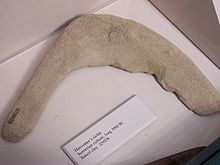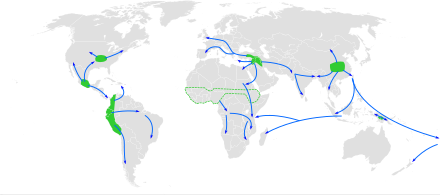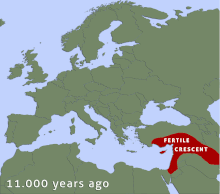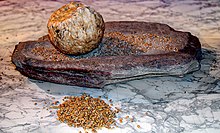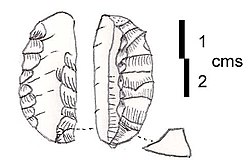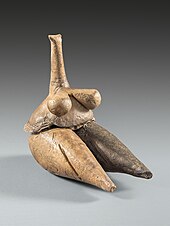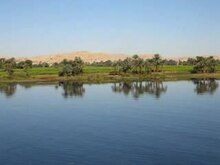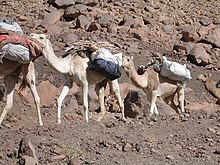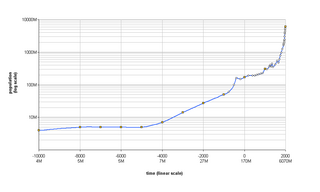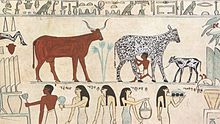The Neolithic Revolution, Neolithic Demographic Transition, Agricultural Revolution, or First Agricultural Revolution, was the wide-scale transition of many human cultures during the Neolithic period from a lifestyle of hunting and gathering to one of agriculture and settlement, making an increasingly larger population possible. These settled communities permitted humans to observe and experiment with plants to learn how they grew and developed. This new knowledge led to the domestication of plants.
Archaeological data indicates that the domestication of various types of plants and animals happened in separate locations worldwide, starting in the geological epoch of the Holocene around 12,500 years ago. It was the world's first historically verifiable revolution in agriculture. The Neolithic Revolution greatly narrowed the diversity of foods available, resulting in a downturn in human nutrition.
The Neolithic Revolution involved far more than the adoption of a limited set of food-producing techniques. During the next millennia it would transform the small and mobile groups of hunter-gatherers that had hitherto dominated human pre-history into sedentary (non-nomadic) societies based in built-up villages and towns. These societies radically modified their natural environment by means of specialized food-crop cultivation, with activities such as irrigation and deforestation which allowed the production of surplus food. Other developments found very widely are the domestication of animals, pottery, polished stone tools, and rectangular houses.
These developments, sometimes called the Neolithic package, provided the basis for densely populated settlements, specialization and division of labour, more trade, the development of non-portable art and architecture, centralized administrations and political structures, hierarchical ideologies, depersonalized systems of knowledge (e.g. writing), and property ownership. The earliest known civilization developed in Sumer in southern Mesopotamia (c. 5,500 BP); its emergence also heralded the beginning of the Bronze Age.
The relationship of the above-mentioned Neolithic characteristics to the onset of agriculture, their sequence of emergence, and empirical relation to each other at various Neolithic sites remains the subject of academic debate, and varies from place to place, rather than being the outcome of universal laws of social evolution. The Levant saw the earliest developments of the Neolithic Revolution from around 10,000 BCE, followed by sites in the wider Fertile Crescent.
Agricultural transition
Map
of the world showing approximate centers of origin of agriculture and
its spread in prehistory: the Fertile Crescent (11,000 BP), the Yangtze
and Yellow River basins (9,000 BP) and the New Guinea Highlands
(9,000–6,000 BP), Central Mexico (5,000–4,000 BP), Northern South
America (5,000–4,000 BP), sub-Saharan Africa (5,000–4,000 BP, exact
location unknown), eastern North America (4,000–3,000 BP).
Knap of Howar farmstead on a site occupied from 3,700 BC to 2,800 BC
The term Neolithic Revolution was coined in 1923 by V. Gordon Childe to describe the first in a series of agricultural revolutions in Middle Eastern history. The period is described as a "revolution" to denote its importance, and the great significance and degree of change affecting the communities in which new agricultural practices were gradually adopted and refined.
The beginning of this process in different regions has been dated from 10,000 to 8,000 BC in the Fertile Crescent and perhaps 8000 BC in the Kuk Early Agricultural Site of Melanesia. This transition everywhere seems associated with a change from a largely nomadic hunter-gatherer way of life to a more settled, agrarian-based one, with the inception of the domestication of various plant and animal species—depending on the species locally available, and probably also influenced by local culture. Recent archaeological research suggests that in some regions such as the Southeast Asian peninsula, the transition from hunter-gatherer to agriculturalist was not linear, but region-specific.
There are several competing (but not mutually exclusive) theories as to the factors that drove populations to take up agriculture. The most prominent of these are:
- The Oasis Theory, originally proposed by Raphael Pumpelly in 1908, popularized by V. Gordon Childe in 1928 and summarised in Childe's book Man Makes Himself. This theory maintains that as the climate got drier due to the Atlantic depressions shifting northward, communities contracted to oases where they were forced into close association with animals, which were then domesticated together with planting of seeds. However, today this theory has little support amongst archaeologists because subsequent climate data suggests that the region was getting wetter rather than drier.
- The Hilly Flanks hypothesis, proposed by Robert Braidwood in 1948, suggests that agriculture began in the hilly flanks of the Taurus and Zagros mountains, where the climate was not drier as Childe had believed, and fertile land supported a variety of plants and animals amenable to domestication.
- The Feasting model by Brian Hayden suggests that agriculture was driven by ostentatious displays of power, such as giving feasts, to exert dominance. This required assembling large quantities of food, which drove agricultural technology.
- The Demographic theories proposed by Carl Sauer and adapted by Lewis Binford and Kent Flannery posit an increasingly sedentary population that expanded up to the carrying capacity of the local environment and required more food than could be gathered. Various social and economic factors helped drive the need for food.
- The evolutionary/intentionality theory, developed by David Rindos and others, views agriculture as an evolutionary adaptation of plants and humans. Starting with domestication by protection of wild plants, it led to specialization of location and then full-fledged domestication.
- Peter Richerson, Robert Boyd, and Robert Bettinger make a case for the development of agriculture coinciding with an increasingly stable climate at the beginning of the Holocene. Ronald Wright's book and Massey Lecture Series A Short History of Progress popularized this hypothesis.
- The postulated Younger Dryas impact event, claimed to be in part responsible for megafauna extinction and ending the last glacial period, could have provided circumstances that required the evolution of agricultural societies for humanity to survive. The agrarian revolution itself is a reflection of typical overpopulation by certain species following initial events during extinction eras; this overpopulation itself ultimately propagates the extinction event.
- Leonid Grinin argues that whatever plants were cultivated, the independent invention of agriculture always took place in special natural environments (e.g., South-East Asia). It is supposed that the cultivation of cereals started somewhere in the Near East: in the hills of Palestine or Egypt. So Grinin dates the beginning of the agricultural revolution within the interval 12,000 to 9,000 BP, though in some cases the first cultivated plants or domesticated animals' bones are even of a more ancient age of 14–15 thousand years ago.
- Andrew Moore suggested that the Neolithic Revolution originated over long periods of development in the Levant, possibly beginning during the Epipaleolithic. In "A Reassessment of the Neolithic Revolution", Frank Hole further expanded the relationship between plant and animal domestication. He suggested the events could have occurred independently over different periods of time, in as yet unexplored locations. He noted that no transition site had been found documenting the shift from what he termed immediate and delayed return social systems. He noted that the full range of domesticated animals (goats, sheep, cattle and pigs) were not found until the sixth millennium at Tell Ramad. Hole concluded that "close attention should be paid in future investigations to the western margins of the Euphrates basin, perhaps as far south as the Arabian Peninsula, especially where wadis carrying Pleistocene rainfall runoff flowed."
Domestication of plants
Spread to Europe
Neolithic grindstone or quern for processing grain
Once agriculture started gaining momentum, around 9000 BC, human activity resulted in the selective breeding of cereal grasses (beginning with emmer, einkorn and barley), and not simply of those that would favour greater caloric returns through larger seeds. Plants with traits such as small seeds or bitter taste would have been seen as undesirable. Plants that rapidly shed their seeds on maturity tended not to be gathered at harvest, therefore not stored and not seeded the following season; years of harvesting selected for strains that retained their edible seeds longer.
Several plant species, the "pioneer crops" or Neolithic founder crops, were identified by Daniel Zohary, who highlighted the importance of the three cereals, and suggested that domestication of flax, peas, chickpeas, bitter vetch and lentils came a little later. Based on analysis of the genes of domesticated plants, he preferred theories of a single, or at most a very small number of domestication events for each taxon that spread in an arc from the Levantine corridor around the Fertile Crescent and later into Europe. Gordon Hillman and Stuart Davies carried out experiments with wild wheat varieties to show that the process of domestication would have occurred over a relatively short period of between 20 and 200 years. Some of these pioneering attempts failed at first and crops were abandoned, sometimes to be taken up again and successfully domesticated thousands of years later: rye, tried and abandoned in Neolithic Anatolia, made its way to Europe as weed seeds and was successfully domesticated in Europe, thousands of years after the earliest agriculture. Wild lentils presented a different problem: most of the wild seeds do not germinate in the first year; the first evidence of lentil domestication, breaking dormancy in their first year, was found in the early Neolithic at Jerf el Ahmar (in modern Syria), and quickly spread south to the Netiv HaGdud site in the Jordan Valley. This process of domestication allowed the founder crops to adapt and eventually become larger, more easily harvested, more dependable in storage and more useful to the human population.
An
"Orange slice" sickle blade element with inverse, discontinuous retouch
on each side, not denticulated. Found in large quantities at Qaraoun II
and often with Heavy Neolithic tools in the flint workshops of the
Beqaa Valley in Lebanon. Suggested by James Mellaart to be older than
the Pottery Neolithic of Byblos (around 8,400 cal. BP).
Selectively propagated figs, wild barley and wild oats were cultivated at the early Neolithic site of Gilgal I, where in 2006 archaeologists found caches of seeds of each in quantities too large to be accounted for even by intensive gathering, at strata datable to c. 11,000 years ago. Some of the plants tried and then abandoned during the Neolithic period in the Ancient Near East, at sites like Gilgal, were later successfully domesticated in other parts of the world.
Once early farmers perfected their agricultural techniques like irrigation, their crops would yield surpluses that needed storage. Most hunter gatherers could not easily store food for long due to their migratory lifestyle, whereas those with a sedentary dwelling could store their surplus grain. Eventually granaries were developed that allowed villages to store their seeds longer. So with more food, the population expanded and communities developed specialized workers and more advanced tools.
The process was not as linear as was once thought, but a more complicated effort, which was undertaken by different human populations in different regions in many different ways.
In the Fertile Crescent
Clay human figurine (Fertility goddess) Tappeh Sarab, Kermanshah, c. 7000–6100 BC
Early agriculture is believed to have originated and become widespread in Southwest Asia around 10,000–9,000 BP, though earlier individual sites have been identified. The Fertile Crescent region of Southwest Asia is the centre of domestication for three cereals (einkorn wheat, emmer wheat and barley), four legumes (lentil, pea, bitter vetch and chickpea), and flax. Domestication was a slow process involving multiple sites for each crop.
Finds of large quantities of seeds and a grinding stone at the paleolithic site of Ohalo II in the vicinity of the Sea of Galilee, dated to around 19,400 BP, has shown some of the earliest evidence for advanced planning of plant food consumption and suggests that humans at Ohalo II processed the grain before consumption. Tell Aswad is the oldest site of agriculture, with domesticated emmer wheat dated to 10,800 BP. Soon after came hulled, two-row barley found domesticated earliest at Jericho in the Jordan valley and Iraq ed-Dubb in Jordan. Other sites in the Levantine corridor that show the first evidence of agriculture include Wadi Faynan 16 and Netiv Hagdud. Jacques Cauvin noted that the settlers of Aswad did not domesticate on site, but "arrived, perhaps from the neighbouring Anti-Lebanon, already equipped with the seed for planting". The Heavy Neolithic Qaraoun culture has been identified at around fifty sites in Lebanon around the source springs of the River Jordan, but never reliably dated.
In China
Northern China appears to have been the domestication center for foxtail millet (Setaria italica) and broomcorn millet (Panicum miliaceum) with evidence of domestication of these species approximately 8,000 years ago. These species were subsequently widely cultivated in the Yellow River basin (7,500 years ago). Rice was domesticated in southern China later on. Soybean was domesticated in northern China 4,500 years ago. Orange and peach also originated in China. They were cultivated around 2500 BC.In Africa
Nile River Valley, Egypt
On the African continent, three areas have been identified as independently developing agriculture: the Ethiopian highlands, the Sahel and West Africa. By contrast, Agriculture in the Nile River Valley is thought to have developed from the original Neolithic Revolution in the Fertile Crescent. Many grinding stones are found with the early Egyptian Sebilian and Mechian cultures and evidence has been found of a neolithic domesticated crop-based economy dating around 7,000 BP. Unlike the Middle East, this evidence appears as a "false dawn" to agriculture, as the sites were later abandoned, and permanent farming then was delayed until 6,500 BP with the Tasian and Badarian cultures and the arrival of crops and animals from the Near East.
Bananas and plantains, which were first domesticated in Southeast Asia, most likely Papua New Guinea, were re-domesticated in Africa possibly as early as 5,000 years ago. Asian yams and taro were also cultivated in Africa.
The most famous crop domesticated in the Ethiopian highlands is coffee. In addition, khat, ensete, noog, teff and finger millet were also domesticated in the Ethiopian highlands. Crops domesticated in the Sahel region include sorghum and pearl millet. The kola nut was first domesticated in West Africa. Other crops domesticated in West Africa include African rice, yams and the oil palm.
Agriculture spread to Central and Southern Africa in the Bantu expansion during the 1st millennium BC to 1st millennium AD.
In the Americas
Maize (corn), beans and squash were among the earliest crops domesticated in Mesoamerica, with maize beginning about 4000 BC, squash as early as 6000 BC, and beans by no later than 4000 BC. Potatoes and manioc were domesticated in South America. In what is now the eastern United States, Native Americans domesticated sunflower, sumpweed and goosefoot around 2500 BC. Sedentary village life based on farming did not develop until the second millennium BC, referred to as the formative period.In New Guinea
Evidence of drainage ditches at Kuk Swamp on the borders of the Western and Southern Highlands of Papua New Guinea shows evidence of the cultivation of taro and a variety of other crops, dating back to 11,000 BP. Two potentially significant economic species, taro (Colocasia esculenta) and yam (Dioscorea sp.), have been identified dating at least to 10,200 calibrated years before present (cal BP). Further evidence of bananas and sugarcane dates to 6,950 to 6,440 BP. This was at the altitudinal limits of these crops, and it has been suggested that cultivation in more favourable ranges in the lowlands may have been even earlier. CSIRO has found evidence that taro was introduced into the Solomon Islands for human use, from 28,000 years ago, making taro cultivation the earliest crop in the world. It seems to have resulted in the spread of the Trans–New Guinea languages from New Guinea east into the Solomon Islands and west into Timor and adjacent areas of Indonesia. This seems to confirm the theories of Carl Sauer who, in "Agricultural Origins and Dispersals", suggested as early as 1952 that this region was a centre of early agriculture.Domestication of animals
When hunter-gathering began to be replaced by sedentary food production it became more profitable to keep animals close at hand. Therefore, it became necessary to bring animals permanently to their settlements, although in many cases there was a distinction between relatively sedentary farmers and nomadic herders. The animals' size, temperament, diet, mating patterns, and life span were factors in the desire and success in domesticating animals. Animals that provided milk, such as cows and goats, offered a source of protein that was renewable and therefore quite valuable. The animal’s ability as a worker (for example ploughing or towing), as well as a food source, also had to be taken into account. Besides being a direct source of food, certain animals could provide leather, wool, hides, and fertilizer. Some of the earliest domesticated animals included dogs (East Asia, about 15,000 years ago), sheep, goats, cows, and pigs.Domestication of animals in the Middle East
Dromedary caravan in Algeria
The Middle East served as the source for many animals that could be domesticated, such as sheep, goats and pigs. This area was also the first region to domesticate the dromedary. Henri Fleisch discovered and termed the Shepherd Neolithic flint industry from the Bekaa Valley in Lebanon and suggested that it could have been used by the earliest nomadic shepherds. He dated this industry to the Epipaleolithic or Pre-Pottery Neolithic as it is evidently not Paleolithic, Mesolithic or even Pottery Neolithic. The presence of these animals gave the region a large advantage in cultural and economic development. As the climate in the Middle East changed and became drier, many of the farmers were forced to leave, taking their domesticated animals with them. It was this massive emigration from the Middle East that would later help distribute these animals to the rest of Afroeurasia. This emigration was mainly on an east-west axis of similar climates, as crops usually have a narrow optimal climatic range outside of which they cannot grow for reasons of light or rain changes. For instance, wheat does not normally grow in tropical climates, just like tropical crops such as bananas do not grow in colder climates. Some authors, like Jared Diamond, have postulated that this East-West axis is the main reason why plant and animal domestication spread so quickly from the Fertile Crescent to the rest of Eurasia and North Africa, while it did not reach through the North-South axis of Africa to reach the Mediterranean climates of South Africa, where temperate crops were successfully imported by ships in the last 500 years. Similarly, the African Zebu of central Africa and the domesticated bovines of the fertile-crescent — separated by the dry sahara desert — were not introduced into each other's region.
Consequences
Social change
World population (estimated) did not rise for a few millennia after the Neolithic revolution.
Despite the significant technological advance, the Neolithic revolution did not lead immediately to a rapid growth of population. Its benefits appear to have been offset by various adverse effects, mostly diseases and warfare.
The introduction of agriculture has not necessarily led to unequivocal progress. The nutritional standards of the growing Neolithic populations were inferior to that of hunter-gatherers. Several ethnological and archaeological studies conclude that the transition to cereal-based diets caused a reduction in life expectancy and stature, an increment in infant mortality and infectious diseases, the development of chronic, inflammatory or degenerative diseases (such as obesity, type 2 diabetes and cardiovascular diseases) and multiple nutritional deficiencies, including vitamin deficiencies, iron deficiency anemia and mineral disorders affecting bones (such as osteoporosis and rickets) and teeth. Average height went down from 5'10" (178 cm) for men and 5'6" (168 cm) for women to 5'5" (165 cm) and 5'1" (155 cm), respectively, and it took until the twentieth century for average human height to come back to the pre-Neolithic Revolution levels.
The traditional view is that agricultural food production supported a denser population, which in turn supported larger sedentary communities, the accumulation of goods and tools, and specialization in diverse forms of new labor. The development of larger societies led to the development of different means of decision making and to governmental organization. Food surpluses made possible the development of a social elite who were not otherwise engaged in agriculture, industry or commerce, but dominated their communities by other means and monopolized decision-making. Jared Diamond (in The World Until Yesterday) identifies the availability of milk and cereal grains as permitting mothers to raise both an older (e.g. 3 or 4 year old) and a younger child concurrently. The result is that a population can increase more rapidly. Diamond points out that agriculture brought about deep social divisions and encouraged gender inequality.
Subsequent revolutions
Domesticated cow being milked in Ancient Egypt
Andrew Sherratt has argued that following upon the Neolithic Revolution was a second phase of discovery that he refers to as the secondary products revolution. Animals, it appears, were first domesticated purely as a source of meat. The Secondary Products Revolution occurred when it was recognised that animals also provided a number of other useful products. These included:
- hides and skins (from undomesticated animals)
- manure for soil conditioning (from all domesticated animals)
- wool (from sheep, llamas, alpacas, and Angora goats)
- milk (from goats, cattle, yaks, sheep, horses and camels)
- traction (from oxen, onagers, donkeys, horses, camels and dogs)
- guarding and herding assistance (dogs)
Living in one spot would have more easily permitted the accrual of personal possessions and an attachment to certain areas of land. From such a position, it is argued, prehistoric people were able to stockpile food to survive lean times and trade unwanted surpluses with others. Once trade and a secure food supply were established, populations could grow, and society would have diversified into food producers and artisans, who could afford to develop their trade by virtue of the free time they enjoyed because of a surplus of food. The artisans, in turn, were able to develop technology such as metal weapons. Such relative complexity would have required some form of social organisation to work efficiently, so it is likely that populations that had such organisation, perhaps such as that provided by religion, were better prepared and more successful. In addition, the denser populations could form and support legions of professional soldiers. Also, during this time property ownership became increasingly important to all people. Ultimately, Childe argued that this growing social complexity, all rooted in the original decision to settle, led to a second Urban Revolution in which the first cities were built.
